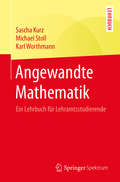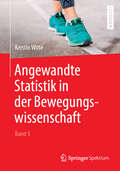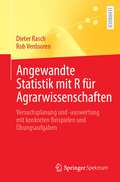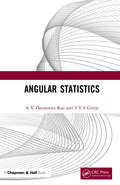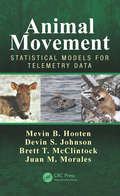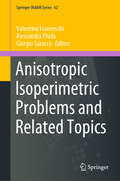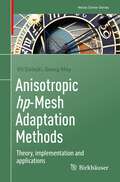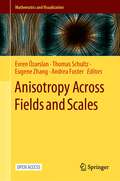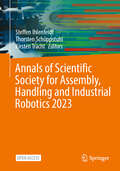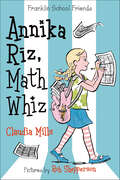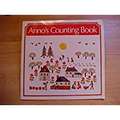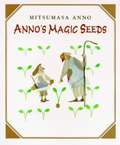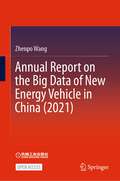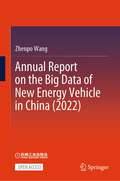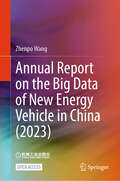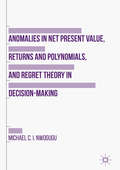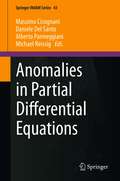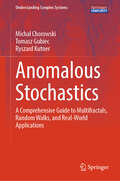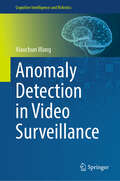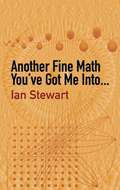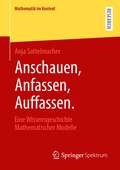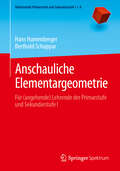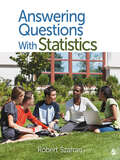- Table View
- List View
Angewandte Mathematik: Ein Lehrbuch für Lehramtsstudierende
by Sascha Kurz Michael Stoll Karl WorthmannMathematik! Aber wozu soll das bitte gut sein? Fast jede Lehrerin und jeder Lehrer wurde bereits mit dieser Frage konfrontiert. Dieses Buch macht den (Mehr-)Wert von Mathematik erfahrbar, indem Sie Algorithmen kennenlernen, mit denen Sie eine Vielzahl praktisch relevanter Probleme lösen können.Aufbauend auf Grundkenntnissen der Analysis und linearen Algebra unternehmen wir einen Streifzug durch die Angewandte Mathematik:Angefangen mit dem Lösen linearer und nichtlinearer Gleichungssysteme über die lineare Optimierung bis hin zu modernen Verfahren der Computeralgebra. So finden Sie leicht ein passendes Thema, um die Lebenswelt Ihrer Schülerinnen und Schüler aktiv mit mathematischen Methoden zu verknüpfen: Sei es, indem Sie die Bevölkerungsentwicklung basierend auf realen Daten prognostizieren oder wirtschaftliche Prozesse optimieren. Oder auch, indem Sie vermeintlich altbekannte Aufgaben wie die Multiplikation so lange kneten, bis Sie und Ihr Computer sie wirklich schnell und effizient lösen. So bekommen Sie unter anderem neue Impulse für Schwerpunktthemen oder Facharbeiten.
Angewandte Statistik in der Bewegungswissenschaft (Band 3)
by Kerstin WitteDieses Buch soll Studierende als auch Doktoranden motivieren, eigene Studien mit dem richtigen Untersuchungsdesign zu planen und durchzuführen.Für viele bewegungswissenschaftliche Untersuchungen müssen statistische Verfahren angewendet werden. Doch oft fällt es den Studierenden schwer, das jeweils geeignete Verfahren zu finden. Dieser Band soll helfen, insbesondere Studierenden der Sportwissenschaft zu helfen, die statistischen Grundlagen zu verstehen. Dabei unterstützt eine Vielzahl von Übersichten über die Verfahren und Abbildungen ihre Wirkungsweise. Viele sportmotorische Beispiele werden erläutert, um die Anwendbarkeit und den Praxisbezug zu demonstrieren. Zu den vertiefenden Aufgaben gibt es auch einen Abschnitt mit Hinweisen zur Lösung der in Band 2 gestellten empirischen Aufgaben.Auf folgende Themenschwerpunkte wird besonders eingegangen: empirische Forschungsmethoden, deskriptive Statistik, Wahrscheinlichkeitstheorie, Parameterschätzung, Aufstellen und Prüfen von Hypothesen, Verfahren zum Testen von Unterschieds- und Zusammenhangshypothesen, Varianzanalyse, Faktorenanalyse, Testtheorie und Zeitreihenanalyse.
Angewandte Statistik mit R für Agrarwissenschaften: Versuchsplanung und -auswertung mit konkreten Beispielen und Übungsaufgaben
by Dieter Rasch Rob VerdoorenDieses Buch führt in die angewandte Statistik für Agrarwissenschaften ein und unterstützt bei der Forschung in der Pflanzen- und Tierproduktion und im Feldversuchswesen. Es nutzt ausgiebig das frei verfügbare Programmpaket R: Über das gesamte Buch hinweg werden im Rahmen umfangreicher Beispiele passende R-Programmcodes angegeben und erläutert. Die Codes können mit eigenen Daten kombiniert und so zur Planung und Auswertung eigener Versuche verwendet werden. So können etwa Wachstumsfunktionen angepasst, Varianzanalysen berechnet oder optimale Versuchspläne und minimale Stichprobenumfänge gefunden werden und vieles mehr. Eine Installationsbeschreibung für R wird ebenfalls zur Verfügung gestellt. Zahlreiche Übungsaufgaben mit Lösungen ergänzen das Buch, so dass es als Lehr- und Nachschlagewerk nutzbar ist. Besonders hervorzuheben ist, dass auch balancierte unvollständige Blockanlagen (BUB) erläutert werden und erstmalig eine vollständige Liste kleinster (mit möglichst geringer Anzahl von Blocks) BUB für bis zu v = 25 Behandlungen und Blockgrößen ≤ v/2 im Netz zur Verfügung gestellt wird. Für Sortenversuche sind die BUB allerdings oft nicht nutzbar, weil sie zu viele Wiederholungen erfordern. Dafür haben sich „verallgemeinerte Gitter“ oder alpha-Anlagen bewährt, die ebenfalls behandelt werden.
Angewandte Statistik: Eine Einführung für Biologen und Mediziner
by Werner TimischlDie "Angewandte Statistik" ist ein Lehr- und Übungsbuch für Anwenderinnen und Anwender der Statistik, die ein Verständnis für statistische Methoden und eine Sicherheit in der Anwendung dieser Methoden erwerben wollen. Vorausgesetzt wird nur die Kenntnis der für den Universtäts- oder Fachhochschulzugang erforderlichen Schulmathematik. Das Lehrbuch führt zuerst in die Wahrscheinlichkeitsrechnung ein und stellt grundlegende Wahrscheinlichkeitsverteilungen vor. Ausführlich werden die Parameterschätzung und das Testen von Hypothesen behandelt. Mit den gängigen Korrelationsmaßen und ausgewählten Regressionsmodellen wird die statistische Grundbildung abgerundet. Die Kapitel über varianzanalytische Modelle und multivariate Verfahren geben einen Einblick in zwei weitere, für die statistische Praxis relevante Gebiete. Darüber hinaus werden Vertiefungen und spezielle Anwendungen in ergänzenden Abschnitten bereitgestellt. Zahlreiche, vollständig durchgerechnete Beispiele und Übungsaufgaben mit einem ausführlichen Lösungsteil machen die "Angewandte Statistik" zu einem Arbeitsbuch, das sich auch zum Selbststudium eignet. Die Ausrichtung auf die Statistik-Software R (durch Verweise auf die entsprechenden R-Funktionen und die Angabe des R-Codes bei den Lösungen der Aufgaben) trägt der Bedeutung computerunterstützter Problemlösungen in der statistischen Praxis Rechnung.
Angular Statistics
by A V Rao S V GirijaDirectional data arise in the form of circular / semicircular / axial, symmetric / asymmetric, uni / bimodal data, in practical situations of varied fields. For the purpose of modeling such kind of data sets, the data scientists found that existing models as inadequate. As there is paucity of angular models, and to fill the gap, this book is designed at constructing new angular models with the existing techniques and to develop new tools of constructing angular models with an application to control charts in angular models. This book is planned to cover the following topics in nine chapters Wrapped, stereographic and offset circular models Construction of angular models using Rising Sun function, positive definite sequences, discretization and through differential approach Extemporaneous Semicircular / arc and asymmetric l – axial models Choice of angular models as an inferential aspect and construction of control charts for angular data as an application are presented. This graduate level book will be useful for data scientists, researchers and research students of Statistics and allied fields.
Animal Movement: Statistical Models for Telemetry Data
by Juan M. Morales Mevin B. Hooten Devin S. Johnson Brett T. McClintockThe study of animal movement has always been a key element in ecological science, because it is inherently linked to critical processes that scale from individuals to populations and communities to ecosystems. Rapid improvements in biotelemetry data collection and processing technology have given rise to a variety of statistical methods for characterizing animal movement. The book serves as a comprehensive reference for the types of statistical models used to study individual-based animal movement. Animal Movement is an essential reference for wildlife biologists, quantitative ecologists, and statisticians who seek a deeper understanding of modern animal movement models. A wide variety of modeling approaches are reconciled in the book using a consistent notation. Models are organized into groups based on how they treat the underlying spatio-temporal process of movement. Connections among approaches are highlighted to allow the reader to form a broader view of animal movement analysis and its associations with traditional spatial and temporal statistical modeling. After an initial overview examining the role that animal movement plays in ecology, a primer on spatial and temporal statistics provides a solid foundation for the remainder of the book. Each subsequent chapter outlines a fundamental type of statistical model utilized in the contemporary analysis of telemetry data for animal movement inference. Descriptions begin with basic traditional forms and sequentially build up to general classes of models in each category. Important background and technical details for each class of model are provided, including spatial point process models, discrete-time dynamic models, and continuous-time stochastic process models. The book also covers the essential elements for how to accommodate multiple sources of uncertainty, such as location error and latent behavior states. In addition to thorough descriptions of animal movement models, differences and connections are also emphasized to provide a broader perspective of approaches.
Animales a bordo: Animals on Board (Spanish Edition) (MathStart 2)
by Stuart J. Murphy“Kids, young and old, fall in love with math when they see how real-life and effortless it becomes thanks to these books.” —Kimberly D. Mueller, Ed.D., First Grade Teacher, Ashbrook School, Lumberton NJThis high-quality Spanish-language book can be enjoyed by fluent Spanish speakers as well as those learning the language, whether at home or in a classroom.Sáobete al camián de Jill y su perro y suma junto con ellos los animales que ven pasar en el camino. Estos animales son muy especiales y van a un lugar que te sorprendera.The MathStart series has sold over 1.5 million copies and combines math with fun stories that have real-life applications. In Animales a bordo, a Level Two MathStart, simple addition equations help children to understand basic arithmetical operations.Math skills are life skills, and the MathStart series supports success!This award-winning series by Stuart J. Murphy teaches math through stories and visual models63 books divided into three levels with 21 books in eachFun activities kids will love are included to help parents and teachers emphasize the lessonsEngaging and relatable stories, with each story revolving around practical applications of the math concept presentedLively art from top-notch illustratorsCharts and other visual representations help children understand how the math works and promote deeper comprehensionMathStart's unique combination of stories, illustrations, and visual models helps teachers and parents in the teaching of math and provides all children with the opportunity to succeed.The math concepts taught in MathStart books conform to state and national standards. Level 1 is Pre-K–Kindergarten; Level 2 is Grades 1–3; Level 3 is Grades 2–4. The series follows math topics across grades so there is a foundational path to learning that runs through the levels.Help kids with their math skills plus their reading skills with the engaging and fun MathStart series!
Anisotropic Isoperimetric Problems and Related Topics (Springer INdAM Series #62)
by Valentina Franceschi Alessandra Pluda Giorgio SaraccoThis book contains contributions from speakers at the "Anisotropic Isoperimetric Problems & Related Topics" conference in Rome, held from Sep 5 to 9, 2022. The classic isoperimetric problem has fascinated mathematicians of all eras, starting from the ancient Greeks, due to its simple statement: what are the sets of a given volume with minimal perimeter? The problem is mathematically well understood, and it plays a crucial role in explaining physical phenomena such as soap bubble shapes. Variations of the problem, including weighted counterparts with density dependencies, representing inhomogeneity and anisotropy of the medium, broaden its applicability, even in non-Euclidean environments, and they allow for descriptions, e.g., of crystal shapes. At large, the perimeter's physical interpretation is that of an attractive force; hence, it also appears in describing systems of particles where a balance between attractive and repulsive forces appears. A prominent example is that of Gamow's liquid drop model for atomic nuclei, where protons are subject to the strong nuclear attractive force (represented by the perimeter) and the electromagnetic repulsive force (represented by a nonlocal term). Such a model has been shown to be sound, as it explains the basic characteristics of the nuclei, and it successfully predicts nuclear fission for nuclei with a large atomic number. Similar energy functionals model various physical and biological systems, showcasing the competition between short-range interfacial and long-range nonlocal terms, leading to pattern formation. The authors mention, e.g., the Ohta–Kawasaki model for microphase separation of diblock copolymers and the Yukawa potential for colloidal systems. Despite diverse systems, the emergence of microphases follows similar patterns, although rigorously proving this phenomenon remains a challenge. The book collects several contributions within these topics, shedding light on the current state of the art.
Anisotropic hp-Mesh Adaptation Methods: Theory, implementation and applications (Nečas Center Series)
by Vít Dolejší Georg MayMesh adaptation methods can have a profound impact on the numerical solution of partial differential equations. If devised and implemented properly, adaptation significantly reduces the size of the algebraic systems resulting from the discretization, while ensuring that applicable error tolerances are met. In this monograph, drawing from many years of experience, the authors give a comprehensive presentation of metric-based anisotropic hp-mesh adaptation methods.A large part of this monograph is devoted to the derivation of computable interpolation error estimates on simplicial meshes, which take into account the geometry of mesh elements as well as the anisotropic features of the interpolated function. These estimates are then used for the optimization of corresponding finite element spaces in a variety of settings. Both steady and time dependent problems are treated, as well as goal-oriented adaptation. Practical aspects of implementation are also explored, including several algorithms. Many numerical experiments using the discontinuous Galerkin method are presented to illustrate the performance of the adaptive techniques.This monograph is intended for scientists and researchers, including doctoral and master-level students. Portions of the text can also be used as study material for advanced university lectures concerning a posteriori error analysis and mesh adaptation.
Anisotropy Across Fields and Scales (Mathematics and Visualization)
by Thomas Schultz Andrea Fuster Evren Özarslan Eugene ZhangThis open access book focuses on processing, modeling, and visualization of anisotropy information, which are often addressed by employing sophisticated mathematical constructs such as tensors and other higher-order descriptors. It also discusses adaptations of such constructs to problems encountered in seemingly dissimilar areas of medical imaging, physical sciences, and engineering. Featuring original research contributions as well as insightful reviews for scientists interested in handling anisotropy information, it covers topics such as pertinent geometric and algebraic properties of tensors and tensor fields, challenges faced in processing and visualizing different types of data, statistical techniques for data processing, and specific applications like mapping white-matter fiber tracts in the brain.The book helps readers grasp the current challenges in the field and provides information on the techniques devised to address them. Further, it facilitates the transfer of knowledge between different disciplines in order to advance the research frontiers in these areas.This multidisciplinary book presents, in part, the outcomes of the seventh in a series of Dagstuhl seminars devoted to visualization and processing of tensor fields and higher-order descriptors, which was held in Dagstuhl, Germany, on October 28–November 2, 2018.
Annals of Scientific Society for Assembly, Handling and Industrial Robotics 2023
by Thorsten Schüppstuhl Kirsten Tracht Steffen IhlenfeldtThis open access book presents a good overview of the current research landscape of assembly, handling and industrial robotics. The objective of MHI Colloquium is the successful networking at both academic and management levels. Thereby, the colloquium focuses an academic exchange at a high level in order to distribute the obtained research results, to determine synergy effects and trends, to connect the actors in person and in conclusion, to strengthen the research field as well as the MHI community. In addition, there is the possibility to become acquainted with the organizing institute. Primary audience is formed by members of the scientific society for assembly, handling and industrial robotics (WGMHI).
Annika Riz, Math Whiz (Franklin School Friends #2)
by Claudia MillsAnnika Riz loves math more than anything, so when she hears about a sudoku contest at the local public library, she is determined to win it—maybe then her friends Kelsey Green and Izzy Barr will see that math is just as cool as reading and running. When the school carnival, the biggest fundraiser of the year, comes around, Annika realizes her class booth is losing money by selling their lemonade too cheaply. Annika embraces her math skills, saves the day, and shows her friends that math can be useful and even a bit of fun, too, in Claudia Mills's Annika Riz, Math Whiz.
Anno's Counting Book
by Mitsumasa AnnoFirst there is an empty field. The it is January, the first month of the year. All alone in the snow stands 1 yellow house. In front, 1 child builds a snowman. Behind the house is 1 tree and 1 black cow. Now, five months later, it is June. There are 6 buildings in the field, 6 children playing, and 6 adults working. One adult tends 6 ducks. Another drives a trains with 6 cars. From 1 to 12, through the months of the year, the town grows. More houses and trees and animals and people can be seen until December arrives with all it's magic.
Anno's Magic Seeds
by Mitsumasa AnnoThe reader is asked to perform a series of arithmetic operations integrated into the story of a man who plants magic seeds and reaps an increasingly abundant harvest. A story that helps children understand the process of plant growth.
Annual Report on the Big Data of New Energy Vehicle in China (2021)
by Zhenpo WangThis open access book, based on static indicators and dynamic big data from local electric vehicles, is the first New-Energy Vehicles (NEVs) research report on the Big Data in China.Using the real-time big data collected by China's National Monitoring and Management Platform for NEVs, this book delves into the main annual technological progress of NEVs, the vehicle operating characteristics, it also anticipates the trend of NEVs industry.Various graphs&charts, detailed data this book offers will familiarize readers with the operation characteristics and practical application of China's NEVs industry and popularize the concept of automobile electrification. Besides, this book also makes an objective evaluation of the current situation and technological improvement of China's NEVs industry, presenting sensible suggestions for the development of the industry.This book is written for government staff, researchers, college staff, and technical staff of automobile and spare parts enterprises, which serves as an important reference for the decision-making of government departments and strategic decisions of automotive companies.
Annual Report on the Big Data of New Energy Vehicle in China (2022)
by Zhenpo WangThis is an Open Access book. This book based on static indicators and dynamic big data from local electric vehicles, is the first New-Energy Vehicles (NEVs) research report on the Big Data in China. Using the real-time big data collected by China's National Monitoring and Management Platform for NEVs, this book delves into the main annual technological progress of NEVs, the vehicle operating characteristics, it also anticipates the trend of NEVs industry.Various graphs & charts, detailed data this book offers will familiarize readers with the operation characteristics and practical application of China's NEVs industry and popularize the concept of automobile electrification. Besides, this book also makes an objective evaluation of the current situation and technological improvement of China's NEVs industry, presenting sensible suggestions for the development of the industry.This book is written for government staff, researchers, college staff, and technical staff of automobile and spare parts enterprises, which serves as an important reference for the decision-making of government departments and strategic decisions of automotive companies.
Annual Report on the Big Data of New Energy Vehicle in China (2023)
by Zhenpo WangThis open access book, based on static indicators and dynamic big data from local electric vehicles, is the first research annual report on the Big Data of New Energy Vehicles (NEVs) in China. Using the real-time big data collected by China's National Monitoring and Management Platform for NEVs, this book delves into the main annual technological progress of NEVs, the vehicle operating characteristics, and it also anticipates the trend of NEVs industry. Various graphs and charts and detailed data this book will familiarize readers with the operation characteristics and practical application of China's NEVs industry and popularize the concept of automobile electrification. Besides, this book also makes an objective evaluation of the current situation and technological improvement of China's NEVs industry, presenting sensible suggestions for the development of the industry. This book is written for government staff, researchers, college staff, and technical staff of automobile and spare parts enterprises, which serves as an important reference for the decision-making of government departments and strategic decisions of automotive companies.
Anomalies in Net Present Value, Returns and Polynomials, and Regret Theory in Decision-Making
by Michael C. I. NwoguguThis book explores why Modified Internal Rate of Return (MIRR) and Net Present Value (NPV) are not necessarily accurate or efficient tools for valuation and decision-making. The author specifically addresses the biases and framing effects inherent in the NPV/MIRR/IRR model and in related approaches such as Adjusted Present Value (APV), Net Future Value (NFV), and by extension, Polynomials. In doing so, the book presents new ways of solving higher order polynomials using invariants and homomorphisms and explains why the "Fundamental Theorem of Algebra", the Binomial Theorem and the "Descartes Sign Rule" are unreliable. Chapters also discuss how International Asset Pricing Theory (IAPT) and Intertemporal Capital Asset Pricing Models (ICAPM) can produce inaccurate results in certain circumstances. The conditions under which ICAPM and IAPT may be accurate are described; as well as why those conditions cannot, or are unlikely to, exist. The conditions under which negative interest rates may exist or are justified are also outlined. Moreover, the author explains why traditional Consumption-Savings-Investment-Production models of allocation can be inefficient, and then introduces a new model of allocation that can be applied to individuals, households and companies. Finally, the book explains why the Elasticity of Intertemporal Substitution is a flawed concept and introduces the Marginal Rate of Intertemporal Joint Substitution as a solution.
Anomalies in Partial Differential Equations (Springer INdAM Series #43)
by Daniele Del Santo Massimo Cicognani Michael Reissig Alberto ParmeggianiThe contributions contained in the volume, written by leading experts in their respective fields, are expanded versions of talks given at the INDAM Workshop "Anomalies in Partial Differential Equations" held in September 2019 at the Istituto Nazionale di Alta Matematica, Dipartimento di Matematica "Guido Castelnuovo", Università di Roma "La Sapienza". The volume contains results for well-posedness and local solvability for linear models with low regular coefficients. Moreover, nonlinear dispersive models (damped waves, p-evolution models) are discussed from the point of view of critical exponents, blow-up phenomena or decay estimates for Sobolev solutions. Some contributions are devoted to models from applications as traffic flows, Einstein-Euler systems or stochastic PDEs as well. Finally, several contributions from Harmonic and Time-Frequency Analysis, in which the authors are interested in the action of localizing operators or the description of wave front sets, complete the volume.
Anomalous Stochastics: A Comprehensive Guide to Multifractals, Random Walks, and Real-World Applications (Understanding Complex Systems)
by Michał Chorowski Tomasz Gubiec Ryszard KutnerThis textbook provides a comprehensive exploration of anomalous stochastic processes and extreme events, commonly referred to as "black swans," with a particular focus on (multi-)fractal approaches and continuous-time random walks. The authors present a systematic examination of the subject, tracing its inception and providing a multi-directional perspective. By drawing on real-world experiences in finance, physics, and technology, the book underscores the practical relevance of anomalous stochastic processes for practitioners dealing with real-world data from complex systems. The content is based on a series of interdisciplinary physics lectures that have been delivered to undergraduate and graduate students at the University of Warsaw for nearly two decades. Updated to reflect recent developments, this book is a valuable resource for graduate students, ambitious undergraduate students, and researchers interested in random processes and the practical implications of anomalous processes. Familiarity with fundamental principles of probability theory, algebra, and basic concepts of differential and integral calculus is assumed, while a foundational understanding of mathematical statistics, stochastic processes, and statistical thermodynamics is recommended. Additionally, each chapter includes practical exercises designed to help readers master the concepts, develop practical skills, and serve as teaching material.
Anomaly Detection in Video Surveillance (Cognitive Intelligence and Robotics)
by Xiaochun WangAnomaly detection in video surveillance stands at the core of numerous real-world applications that have broad impact and generate significant academic and industrial value. The key advantage of writing the book at this point in time is that the vast amount of work done by computer scientists over the last few decades has remained largely untouched by a formal book on the subject, although these techniques significantly advance existing methods of image and video analysis and understanding by taking advantage of anomaly detection in the data mining community and visual analysis in the computer vision community. The proposed book provides a comprehensive coverage of the advances in video based anomaly detection, including topics such as the theories of anomaly detection and machine perception for the functional analysis of abnormal events in general, the identification of abnormal behaviour and crowd abnormal behaviour in particular, the current understanding of computer vision development, and the application of this present understanding towards improving video-based anomaly detection in theory and coding with OpenCV. The book also provides a perspective on deep learning on human action recognition and behaviour analysis, laying the groundwork for future advances in these areas. Overall, the chapters of this book have been carefully organized with extensive bibliographic notes attached to each chapter. One of the goals is to provide the first systematic and comprehensive description of the range of data-driven solutions currently being developed up to date for such purposes. Another is to serve a dual purpose so that students and practitioners can use it as a textbook while researchers can use it as a reference book. A final goal is to provide a comprehensive exposition of the topic of anomaly detection in video media from multiple points of view.
Another Fine Math You've Got Me Into. . .
by Ian StewartPopulated by curious creatures whose stories unfold with jokes and puns, this mathematical wonderland of puzzles and games also imparts significant mathematical ideas. Ian Stewart, an active popularizer of mathematics, university professor, and former columnist for Scientific American's "Mathematical Games" section, has selected 16 of his columns from Pour la Science, the French edition of Scientific American, most based on a mathematical idea dressed up with oddball characters and wacky wordplay.
Anschauen, Anfassen, Auffassen.: Eine Wissensgeschichte Mathematischer Modelle (Mathematik im Kontext)
by Anja SattelmacherDas Herstellen, Sammeln und Verbreiten mathematischer Modelle war im 19. und frühen 20. Jahrhundert weit verbreitete Praxis an Universitäten und technischen Hochschulen.Anhand ausgewählter Modelle im Kontext ihrer Sammlungen lässt sich zeigen, dass das Wissen über mathematische Modelle im Prozess der Modellierung, des Sammelns, des Veräußerns und des Ausstellens generiert wurde. Dabei flossen sowohl künstlerische Praktiken als auch reformpädagogische Überlegungen in dieses Wissen mit ein. Im Zentrum der Studie stehen Mathematikprofessoren, die die Verwendung von Modellen im Kontext der akademischen Lehre auf unterschiedliche Weise vorantrieben. Weniger bekannt ist hingegen, dass auch Frauen einen wichtigen Anteil an der Produktion von Modellen hatten. Das Buch leistet mit den Auswertungen zahlreicher Quellen aus unterschiedlichen Archiven sowie einer ethnographischen Beobachtung eines Modellbauers einen wichtigen Beitrag für eine praxeologisch orientierte Wissenschaftsgeschichte.
Anschauliche Elementargeometrie: Für (angehende) Lehrende der Primarstufe und Sekundarstufe I (Mathematik Primarstufe und Sekundarstufe I + II)
by Berthold Schuppar Hans HumenbergerDieses Lehrbuch unterstützt bei der Vorbereitung eines reizvollen, lebendigen und problemorientierten Geometrieunterrichts in der Primarstufe und Sekundarstufe I. Es macht die entsprechenden Sachverhalte der Elementargeometrie zugänglich und erlebbar, indem geometrische Figuren beschrieben, konstruiert, variiert und analysiert und die beobachteten Phänomene möglichst anschaulich begründet werden. Die vorgeschlagenen Experimente verwenden dabei diverse Materialien – von Papier und Pappe (Falten, Schneiden, Kleben) über klassische Konstruktionen mit Zirkel und Lineal bis hin zur dynamischen Geometrie-Software (DGS) GeoGebra. Entsprechende Grundkenntnisse im Umgang mit GeoGebra werden dabei vorausgesetzt. Im gesamten Buch stehen problemorientierte Ansätze, entdeckendes Lernen, Forschungsaufträge und Anwendungen im Vordergrund. In den ersten Kapiteln werden die zentralen Ziele, Inhalte und Methoden vorgestellt sowie die Inhalte der Schulgeometrie wiederholt. In den späteren Kapiteln werden diese auf einem etwas höheren mathematischen Niveau systematisiert und erweitert, jedoch nicht im Sinne einer axiomatischen Geometrie. Das Buch richtet sich vorrangig an Studierende des Lehramts der Primarstufe und Sekundarstufe I bzw. an Grund-, Haupt- und Realschulen sowie an Lehrende in diesem Bereich.
Answering Questions With Statistics
by Robert F. SzafranFinally, an introductory statistics text that provides broad coverage, limited theory, clear explanations, plenty of practice opportunities, and examples that engage today′s students!Using General Social Survey data from 1980 and 2010, this textbook asks students to consider how young adults have changed over the last 30 years. Students learn to select an appropriate data analysis technique, carry out the analysis, and draw conclusions.
